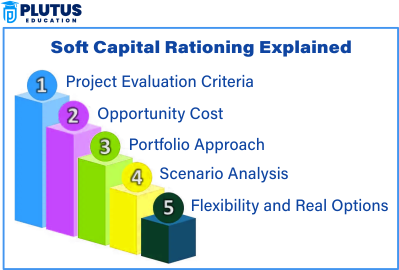The choice of an investment has a limited budget in many businesses and organizations. Soft capital rationing refers to the situation where a firm limits its available funds for investment projects in the presence of a capital market. Soft capital rationing, in contrast to hard capital rationing (which arises from external financial limitations), is a mechanism employed by multidisciplinary management in encouraging opportunities for resource allocation. Businesses adopt this method to manage spending, focus on high-yield projects, and ensure overall economic health.
Soft capital rationing is important to note for any business, particularly those that have a need to consider how to balance growth and financial discipline. This article covers the meaning, definition, examples, reasons, advantages, and differences between soft and hard capital rationing.
What is Soft Capital Rationing?
Soft capital rationing refers to an internal policy wherein companies place limits on investment spending. That’s why businesses will have internal budget ceilings that ensure only projects with the most return are prioritized. Soft capital rationing is done internally, and unlike hard capital rationing, which is derived from market limitations, soft capital rationing is voluntary.
Why Do Companies Use Soft Capital Rationing?
Soft capital rationing is a process by which companies enforce budgets to avoid over spending, ensure funding for high-value projects and lower financial risk. It assists enterprises in liquidity sustainment, operational throughput regulation, and financial optimization.
One such example could be to set a fixed investment amount each year and fund only the projects that provide the utmost value for that investment.
Soft Capital Rationing Definition
Soft capital rationing is an in-house financial policy wherein a company places a cap on available capital for the planned investments albeit funds are accessible. The strategy, in this case, is a guarantee that capital will not be applied to projects that are not promising in terms of the expected returns.
Some of the main characteristics of the soft capital rationing are:
- Voluntary limitation on the issue of investment funds
- Internal budgetary restraints on expenditure
- Proper order of high-return investments
- Tactical capital deployment
Firms frequently use soft capital rationing to avert too much risk, assure that finances are in fact of proper balance, and they focus on their main activities only.

Soft Capital Rationing Example
Understanding soft capital rationing through examples helps in grasping its real-world applications.
Example 1: Manufacturing Firm
A large manufacturer has an annual budget of $50 million for investments. While it has the financial ability to invest more, it chooses instead to limit investment spending at $50 million in order to pursue the more profitable focus projects. Anything outside this budget must either wait or prove its higher return potential.
Example 2: Tech Startup
A venture capital-backed technology startup has R&D expenditure capped at $2 million per quarter.It is for the purposes of making it possible to distribute money between the most viable projects and not spend on those that should not be wasted, and maximise cash flow management.
Example 3: Retail Chain Expansion
For five years, a retail chain has enough funds to open up to ten new stores per year. However, it decides to only open five per year or fewer to reduce the chances of losing its financial stability. This makes it easier to manage resources wisely and mitigates operational risks.
Reasons for Soft Capital Rationing
A soft capital rationing is used by businesses for different strategic and financial reasons. Are among the most important?
1. Risk Management
To mitigate this exposure to financial risk (i.e., adverse market movement, economic recession, and erratic revenue streams), companies tend to constrain the amount of investment spending they make. When it comes to poor market conditions, a company can playsmart by enabling internal barriers to capital allocation. It contributes to keeping a financial cushion to overcome economic recessions and provide long-term sustainability for the company.
2. Optimizing Resource Allocation
Soft capital rationing enables business to invest in highest-return projects. Rather than spending and distributing resources across a repetitive project with a thousand different returns, businesses can focus their capital inside these ventures that create vast profitability. The result is capital employed at maximum efficiency and no wasted overhead on low-yield investments.
3. Maintaining Financial Stability
Internal investing is better than investing in external ventures as it decreases the need for loans or equity issues with high interest rates or dilution of the owners` share. Since companies with a sound financial status are capable to sustain long-term growth.
4. Budgetary Control
Most organizations place internal investment caps within their budget process. A Capital Deployment Control of the organization makes certain that some expenses conform to establishing corporate objectives. It embodies a flexible discipline under which companies are stopped from entering into irrational investments and assists in facilitating the orderly arrangement and deployment of resources.
5. Shareholder Expectations
Investors and shareholders tend to appreciate companies that apply carefulness in finance. Applying soft capital rationing reflects the firm’s long-time planning for investments and carefully directed expenditure. This method throws confident investors and can have a positive effect on stock price valuations and market perceptions.
6. Strategic Business Expansion
Soft capital rationing is commonly practiced by companies to facilitate gradual and sustainable growth. Companies can avoid costly expansion projects and putting financial strain on the organization by spreading out their cash over the long term, rather than aggressively going after every opportunity. This greatly reduces operational risks and helps companies ensure continuous growth without financial strain.
7. Competitive Market Positioning
Controlling investment expenditure will allow firms to deploy the capital to derive maximum competitive advantage. Companies must balance the willingness to invest in innovation, technology, and product development to remain competitive with their discipline to manage costs and cash, and this is all about strategy.
Advantages of Soft Capital Rationing
Hard capital rationing occurs at the external level, whereas soft capital rationing occurs within the firm and has some useful benefits that can help the firm maintain financial discipline and match investment strategy.
- Investment decisions in strategic context: Firms will only invest in projects that give the highest rate of return, thus increasing profits and financial growth.
- Improved Cash Flow Management: Delaying investment spending enables companies to preserve liquidity, i.e., having sufficient funds available to meet operating needs and unexpected costs.
- Controlled Financial Risk: Soft capital rationing allows you to make sure you do not overinvest in great unknowns, limiting your risk of losing a massive portion of your money in the process.
- Increased Shareholder Trust: Financially responsible companies are valued by the investors. You have an assurance for long-term investors with a capital control.
- Sustainable Business Growth: On the other hand, soft capital rationing leads to moderate and steady growth, that avoids putting a strain on resources for rapid expansion, while still maintaining this growth within sustainable limits.
Soft and Hard Capital Rationing: Key Differences
If you need more clarification then it can be done through the difference between soft and hard capital rationing. Soft capital rationing is an internal policy that keeps businesses from losing control over their investments spending activity. On the other hand, hard capital rationing arises from external financial constraints on a company that restrict its capacity to obtain financing for its investment.
It ensures money is only spent on the most profitable ventures. It ensures financial discipline and helps the companies to stay liquid. Hard capital rationing can be harmful to growth because firms can have trouble finding appropriate financing to expand.
| Feature | Soft Capital Rationing | Hard Capital Rationing |
| Definition | Internal restriction on capital allocation | External financial constraints limit investments |
| Cause | Voluntary decision by management | Market conditions, funding limitations |
| Control | Controlled by internal policies | Driven by external financial factors |
| Risk Management | Reduces excessive spending and financial risk | Forces businesses to operate under funding constraints |
| Impact on Growth | Ensures sustainable growth | Can hinder expansion due to lack of funds |
| Flexibility | Higher flexibility in investment decisions | Limited flexibility due to external conditions |
| Funding Sources | Business can access funds but chooses restrictions | Limited or no access to external funds |
Relevance to ACCA Syllabus
Soft capital rationing is relevant from the perspective of the ACCA syllabus, notably in Key areas of FM and AFM. This concept help candidates learn investment appraisal, how to manage risk, and corporate financial planning. Strategic profitability of the company can be maximized by means of capital allocation to the projects with the mediate return and financial sustainability. The subject is questioned at ACCA examinations by means of investment decision making and capital budgeting concepts.
Soft Capital Rationing ACCA Questions
Q1: Why do companies implement soft capital rationing?
A) Due to the unavailability of external funding
B) To restrict capital expenditure of the most beneficial projects that will help achieving a company’s objectives
C) Because of the requirement imposed by investors regarding financing limits
D) Due to financial restraints imposed by the government
Answer: B) To voluntarily limit capital expenditure for strategic reasons
Q2: In capital budgeting soft capital rationing mainly focuses on:
A) Maximizing the company’s working capital
B) Choosing the project on an internal financial basis
C) Getting resources from the external market irrespective of cost
D) Focusing more on short-run profits rather than growth
Answer: B) Selecting projects based on internal financial restrictions
Q3: What is the main characteristic of soft capital rationing?
A) It is a policy of the loaners
B) It is a decision made by the management of the company
C) It is a government policy
D) It blocks the companies from investing in new projects
Answer: B) It is a voluntary financial constraint set by the management
Q4: The soft capital rationing can affect the decisions of companies with respect to investment as it can:
A) Lead the companies into getting too much money at the start of their operations
B) Bar weak projects from being launched and instead launching substantial ones
C) Force the companies to stop seeking additional outlets for their funds
D) Allow them to choose projects without the need for any kind of cost-benefit analysis
Relevance to US CMA Syllabus
Capital budgeting, investment decisions, and financial risk management are included in the Certified management accountant (CMA) syllabus. Soft capital rationing plays an important role in evaluating financial strategies, can ensure funds are spent on the most profitable projects and managing financial constraints. It is, in fact, a key topic in Part 2 of the CMA exam, which deals with financial decision-making and corporate finance.
Soft Capital Rationing US CMA Questions
Q1: The primary objective of soft capital rationing in financial management is:
A) Increase external borrowing
B) Allocate funds efficiently to high-ROI projects
C) Avoid all forms of investment risk
D) Depend on external capital markets for financing
Answer: B) Allocate funds efficiently to high-ROI projects
Q2: Soft capital rationing, in the main, is used for:
A) Avoiding all investment expenditures
B) Managing internal budget constraints and prioritizing investments
C) Completely stopping financial operations
D) Eliminating the need for financial analysis
Answer: B) Managing internal budget constraints and prioritizing investments
Q3: A CFO decides to limit capital spending despite having sufficient funds available. This is an example of:
A) Hard capital rationing
B) Soft capital rationing
C) Financial leverage strategy
D) Arbitrary financial restrictions
Answer: B) Soft capital rationing
Q4: One of the main goals that a company can achieve when applying soft capital rationing is:
A) Increase operational inefficiency
B) Allocate financial resources optimally within a company
C) Seek higher external financing options
D) Eliminate capital budgeting processes
Answer: B) Allocate financial resources optimally within a company
Relevance to CFA Syllabus
Soft capital rationing is an important topic covered in the CFA (Chartered Financial Analyst) curriculum in Corporate Finance as well as Portfolio Management. CFA candidates learn how firms assess capital allocation methods, risk, and the influence of investment project priority. The subject matter is examined in financial analysis, valuation models, and capital structure decisions, and the results appear on Level I and Level II CFA exams.
Soft Capital Rationing CFA Questions
Q1: How does soft capital rationing benefit financial management?
A) It ensures only essential and high-return projects receive funding
B) It restricts all forms of investment regardless of their potential
C) It forces companies to seek external financing
D) It eliminates the need for financial planning
Answer: A) It ensures only essential and high-return projects receive funding
Q2: Which statement best describes soft capital rationing?
A) It is imposed by external financial institutions
B) It is a voluntary internal capital restriction for better financial planning
C) It results from economic downturns and credit shortages
D) It eliminates all investment opportunities for a company
Answer: B) It is a voluntary internal capital restriction for better financial planning
Q3: In corporate finance, soft capital rationing is used to:
A) Reduce access to profitable investment opportunities
B) Prioritize projects based on strategic and financial objectives
C) Increase financial risk without considering returns
D) Allow uncontrolled capital expenditures
Answer: B) Prioritize projects based on strategic and financial objectives
Q4: A firm limits its capital investment to projects with a minimum expected return of 12%. This is an example of:
A) Hard capital rationing
B) Soft capital rationing
C) Market-imposed financial constraints
D) External investment limitations
Answer: B) Soft capital rationing
Relevance to US CPA Syllabus
Soft capital rationing is pertinent to BEC, FAR of US CPA. And it assists CPAs in their role as advisors to firms who deal with strategic planning, risk management and budgeting strategies. This helps in improvement and healthy financial reporting, opportunities for optimal investments and governance of the organization.
Soft Capital Rationing US CPA Questions
Q1: Soft capital rationing primarily involves:
A) Constraints on capital investment imposed from the outside
B) Limits by management on investment expenditures
C) Restrictions for corporate financing imposed by government
D) Financial resources meant for investment are not there
(e) Explain the theory of the (general) A) Management-imposed restrictions on investment spending
Q2: What is the Implications of Soft Capital Rationing on Financial Reporting?
A) Mandates disclosure on external capital constraints by companies
B) Budgeting decisions and financial planning disclosures are affected
C) It requires a compliance with regulations in terms of allocating investments.
D) It removes the cost-benefit analysis from financial reportwriting
A: B) It impacts budgeting choices and financial planning disclosures
Q3: If a company has the funds but chooses to limit its annual capital expenditure, it is said to be:
A) Hard capital rationing
B) Soft capital rationing
C) Financial constraints driven by the market
D) Limitations on Debt-Fueled Investments
Q. The situation described in the question is as follows:
Answer: B) Soft capital rationing
Q4: The financial consequences of soft capital rationing are best described as:
A) It leads to thoughtless investment decisions
B) It pushes firms into obtaining outside debt financing
C) It enhances internal budgeting and investment efficiency
D) It increases reduction of financial control for capital investments
Answer: C) It improves internal budgeting and investment efficiency


